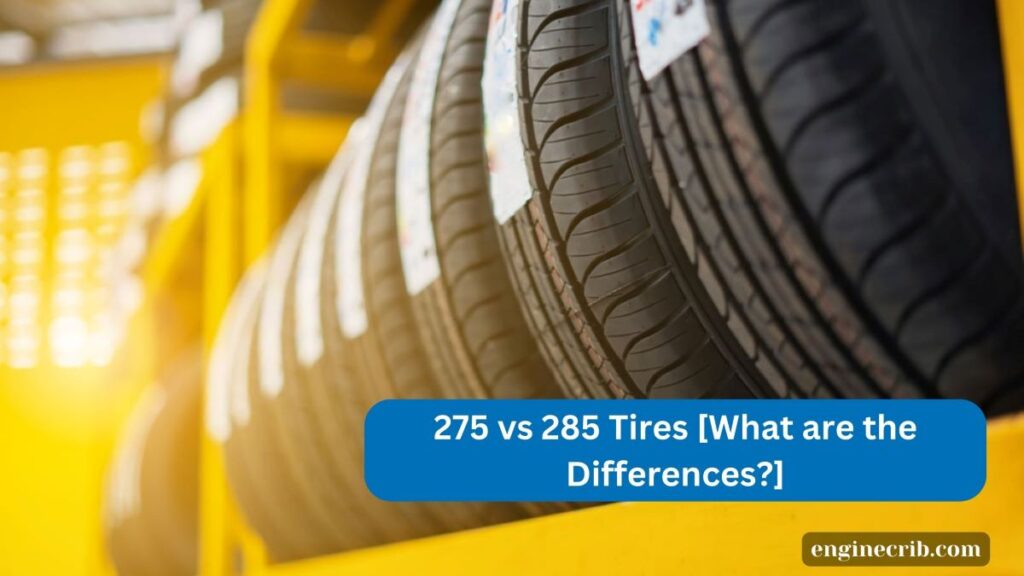Car tires are essential components of the car. They support the weight of the vehicle and transfer traction/braking forces to the road surface.
The performance, fuel efficiency, and general appearance of your car can all be impacted by selecting the proper tire size for your car.
Are you in the market for new tires for your vehicle, and you are wondering if 275 or 285 tires are the best fit for your needs? Read this article till the end.
In this post, we will show you the key differences between 275 and 285 tires, including their dimensions, tread designs, and effects on handling and performance.
Therefore, whether you’re a car enthusiast or just looking to upgrade your tires, this post will give you useful information to aid in your decision-making.

Difference Between 275 and 285 Tires
1. Appearance
The 275 tire is slightly taller than the 285, but it rotates slightly slower than the 285 tires. As a result, the differences are insignificant in terms of interchangeability.
However, the 285s will be your best option if design quality is your thing because they look bigger and better.
They have a more intricate and noticeable tread because the rubber is that much thicker, giving the manufacturers more room to play with, and they fill out the wheel well so that larger trucks don’t look lost.
2. Acceleration
You can attain a different maximum acceleration depending on whether you choose the 275s or the 285s.
Although the top speeds of the 275 tires will be higher than those of the 285, the 285 is better suited for off-roading, so control and handling skills are more important.
3. Price
If you want to buy replacement tires on a budget, the 275 could be your best choice. This is because they are a little smaller, which means less rubber is used in their construction, which won’t cost so much.
Additionally, they are more popular, and there is a larger market for them and more price competition.
The 285 has heavier tires and deeper treads, making it better for off-roading. Due to their thicker sidewalls, they are more expensive.
4. Handling
You can confidently drive on any surface thanks to the 285s’ thicker construction and sidewalls, which give the tire a deeper pattern that offers extraordinary traction on roads, gravel, or sand.
The 275s have some special building features, such as a smoother transition to minimize friction, which improves control, and are stronger for both on- and off-road use, making them more suitable for everyday use.
Basic Features of 275 and 285 Tires
| Features | 285 Tires | 275 Tires |
| Width: Section Rim | 11.2 inches 8-22.0 inches | 8.5 inches 8-9.0 inches |
| Diameter: Tire Rim | 33 inches 16-22 inches | 32 inches 20 inches |
| Tire Weight | 38.0-67.0 pounds | 30.0-43.0 pounds |
| Aspect Ratio | 45.0-75.0 | 45.0-70.0 |
| Load Index Rating | 114.0-126.0 | 111.0-117.0 |
| Load Capacity | 1700-3700 pounds | 1600-2900 pounds |
275 vs 285 Tires Which is Better?
The answer to this question greatly relies on what you want to get out of your tires because they are both better in their unique ways. 275 tires are less expensive, more suitable for use on highways, and lightweight. On the other hand, the 285 tires are more robust, have thicker treads, and have a great appearance.
Is it Possible to Interchange 285 and 275 Tires?
Yes, you can swap 285 tires for 275 tires. Although the 285 tires are slightly wider than the 285, they share the same tread pattern. As a result, you can replace one another without fear of repercussions.
Read: Emissions System Problem
Conclusion
The main difference between the 275 and 285 tires is the width. A 275 tire has a diameter of 275 millimeters, while a 285 tire has a width of 285 millimeters.
Wider tires typically offer better handling and stability, particularly in high-speed situations, while narrower tires generally offer better fuel economy and a smoother ride.
However, there are other factors to take into account when choosing between 275 and 285 tires, such as the size and weight of the car, the types of driving conditions you’ll encounter, and your personal preferences.
It’s important to get guidance from a tire expert or the maker of your vehicle to determine which size is best for your specific needs.